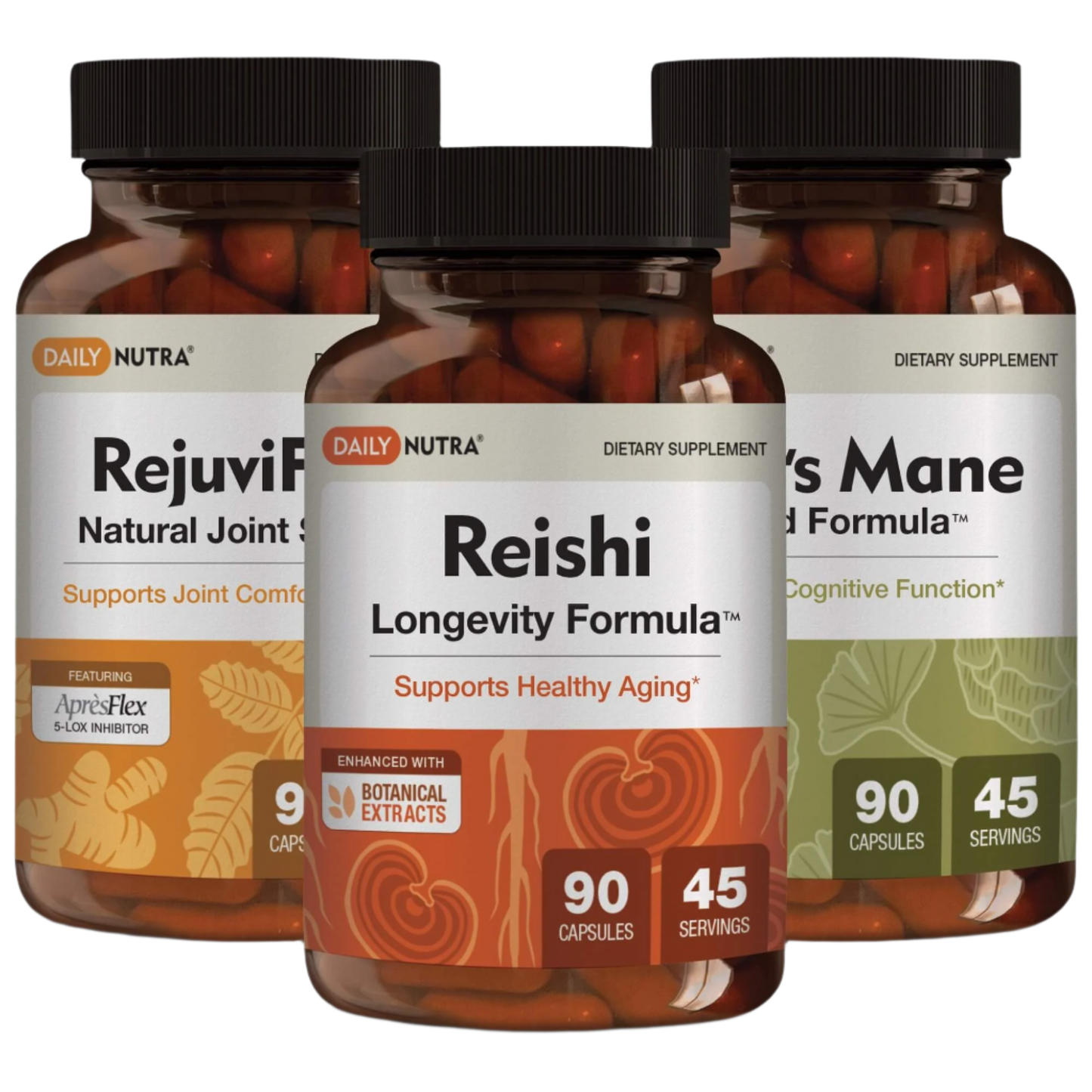
You may be wondering about the benefits of ashwagandha and maca. Although both powerful adaptogens have risen in popularity among the health-conscious population, it can be hard to understand their uniqueness.
Maca and ashwagandha are supplements with ancient roots. They are particularly beneficial for women seeking natural health solutions.
Both directly and indirectly affect almost every organ system in the body.
Key takeaways: One study suggests combining ashwagandha and maca can improve health and wellness outcomes (1).
Different Benefits: Ashwagandha is well suited to treating anxiety and other stress-related conditions as well as hormonal disorders; Maca has energy-giving attributes that increase sexual endurance, as well as acts as a hormonal balancer, especially to women going through menopause.
Nutritional Profiles: Ashwagandha contains chemicals called withanolides that assist with stress relief, and Maca has excellent nutritional value, comprising vitamins, minerals, and amino acids.
Choosing Based on Goals: If your goal is to lower stress or anxiety, select Ashwagandha, while if you want to increase energy and sexual drive, go for Maca.
Origins and Traditional Uses
Ashwagandha, known as the “Queen of Ayurveda herbs,” has an origin that can be traced back thousands of years in the Indian subcontinent.
Today, this potent plant is an essential commodity of the Ayurveda system of health care, which is estimated to be over five thousand years old. Maca has been used for centuries in traditional medicine.
Ashwagandha impacts and affects most functions within the body’s energies and provides a calming effect from the day's stresses.
In Ayurveda, ashwagandha is considered a rasayana, which means it physically and mentally allows one to remain youthful and may improve overall health.
It is especially prized for increasing energy and uniquely relates to feminine physiology; maca powder is often recommended.
Ashwagandha first comes into the light of medical scriptures in the Charaka Samhita, one of the oldest Ayurveda texts written between 200 B.C. and 200.

Maca's Andean Heritage
Moving from continent A to continent B, we learn about maca, a strongly built vegetable with its origin in the Andean plateau of Peru. Maca may improve energy levels and is known for its adaptogenic properties.
Maca, better known as “Peruvian Ginseng,” has been used in Peruvian culture for centuries and is considered one of the benefits of maca.
Its legacy is associated with increased energy, endurance, and sexual vigor.
Ashwagandha can increase serum testosterone levels in adults, making it useful for women suffering from hormonal fluctuations, PMS, and menopausal symptoms.
Historical Applications
Ashwagandha is an herb used in the Ayurvedic system of India, and maca is used in the Peruvian traditional system of medicine.
Ashwagandha has been used to increase sexual strength, enhance the immune system, and increase the strength to do hard work.
It has also been used to manage infertility and boost sexual performance, with ashwagandha extracts showing promise in these areas.
On the other hand, the Andean community has employed maca as a food and herb medicine, known for its benefits of maca in enhancing vitality and supporting reproductive health.
The Filipino people never underestimated the value of corn, which the Spanish colonizers even considered in the 16th century for feeding livestock.
Nutritional Profiles
Numerous bioactive substances found in ashwagandha support general health, while maca is an excellent choice for enhancing energy and endurance. The primary active constituents are withanolides, which are natural steroidal lactones.
They include withanolide A, withaferin A, and with any. Ashwagandha also contains other alkaloids, including isopelletierine andanaferinee.
Other organic compositions identified in the plant are sitoindosides, glycosides, and several amino acids. These components offer ashwagandha root the specified adaptogenic effect, supporting the body’s adjustment to stress and maintaining health and wellness.

Maca's Nutrient Composition
Maca root grows in central Peru and is loaded with essential minerals – making it a nutrient-rich food (2). It comprises approximately 60% carbohydrates, 10% protein, and 2% fat, making it a valuable energy source for improving muscle strength.
Maca is good in vitamins, especially B and C, making it a valuable addition to any health and wellness regimen (3).
It also undergoes ample amounts of detailed calcium, iron, zinc, and magnesium minerals found in maca.
As was covered in the maca features section, the product is a complete protein source due to its abundance of essential amino acids.
Maca also contains two beneficial plant components that enhance its antioxidant qualities: glycosinolates and polyphenols.
These are other examples of secondary metabolites that play a major role in plant defense mechanisms.
Comparative Analysis
Ashwagandha is an herb related to solids, and maca is related to liquids, so they have different nutritional effects.
Ashwagandha boasts withanolides, which are strongly associated with decreasing stress and hormone regulation, while maca may help with energy levels.
In contrast, maca contains far more vitamins, minerals, and a broader spectrum of nutrients than ginseng.
The food is especially rich in iron and calcium; ashwagandha extracts can contribute to overall wellness.
Ashwagandha mainly targets the stress management system, while maca affects the body mainly by boosting nutrient-dense food and energy metabolism.
These two herbs can be used harmoniously to help boost the immune system towards diseases and general health.
Health Benefits
Regarding stress regulation, the two herbs, ashwagandha and mac, share similarities but regulate stress differently.
Foremost among those is Ashwagandha, which is considered one of the most outstanding adaptogens and may improve stress resilience.
Modulating the body’s stress response considerably lowers stress and anxiety levels, and ashwagandha can also play a significant role in this process.
Copy this herb reduces cortisol levels, the leading stress hormone, making a person more emotionally relaxed, while ashwagandha can support stress management.
From his observations, it is common for users to testify that ashwagandha may improve their sense of relaxation and calm when they take it as a daily supplement.
Although maca does not impact stress hormones, its high antioxidant activities may improve the body's ability to combat physical, emotional, and environmental stress; maca is known for its energy-boosting properties.
It might enhance mood and decrease anxiety, more so in postmenopausal ladies, especially when one takes ashwagandha and maca together.
Hormonal Balance
The two adaptogens, ashwagandha and maca, affect hormonal balance differently. Ashwagandha can increase serum testosterone levels in adults.
Ashwagandha has earned a reputation for general hormonal balance, specifically female hormonal balance, and may improve sexual desire; taking ashwagandha and maca together may enhance these effects (4).
Ashwagandha can control menstrual periods, decrease stress before periods, and promote reproductive health and fertility.
It may promote testosterone in males and help them stay erect for longer durations.
Maca is very popular, especially for regulating hormonal imbalances and enhancing libido within couples of both genders.
It benefits women due to hormonal fluctuations during menstrual and menopausal periods.
Thus, Maca may directly modulate the hypothalamic pituitary ovarian axis, which regulates the secretion of sex hormones.

Energy and Performance Improvement
The two herbs are beneficial in boosting energy and exercise performance.
Ashwagandha is an herbal supplement that raises energy levels and is essential for physical vigor and strength. It may increase VO2max and the rate of torque development, among other things.
Maca has been trusted to boost energy, fight fatigue, and naturally boost stamina. For instance, people who participate in athletic activities use it to enhance their body build and strength.
The energy boost obtained from taking maca is usually standard, slow-rising, and sustained long.
How to Choose and Use
Ashwagandha and maca root are good herbs, but one must determine one's wellness objectives, as ashwagandha offers unique benefits.
Compared to similar options on the market, ashwagandha can effectively manage stress and anxiety.
On the other hand, if you require an energy boost or higher performance, maca could be your perfect choice.
Recommended Dosages
The usual dose of ashwagandha should be 250 to 500mg per day. Daily doses of 225-600 mg have been proposed to obtain benefits, together with 1-2 months of use.
Compared to PCP, maca usually necessitates a higher daily dose of 1500-3000 mg, particularly for women (5).
Forms and Preparations
Ashwagandha and maca root, recognized as superfoods, are available in different forms: powders, tablets, capsules, tinctures, and gel.
Ashwagandha is also commonly used in tonics, while maca can be found in various health supplements to support energy and vitality.
Typically, maca is supplied as a simple powder to mix into liquid foods like fruit or vegetable juices; it can also be added to smoothies for an energy boost.
Some products contain both herbs, so you can simultaneously get the effects of ashwagandha and maca root.
Conclusion
Ashwagandha and maca—two adaptogens in traditional medicine systems—affect almost every domain of people’s health and well-being, especially reproductive health.
They include stress and hormonal balance, increased energy and physical performance, and more. Hasyrophyttyli and Ginkgo have distinct qualities yet are adequate for similar purposes, whereas maca and ashwagandha are potent supplements for health enhancement.
Though ashwagandha works wonders in managing stress and anxiety, maca impresses with its nutritive value-enhancing energy boost. For this reason, the decision to take either of these two supplements is informed by one's health requirements and objectives.
Therefore, it is very important to look at the particular effects of specific herbs in relation to specific goals of enhancing human health in our attempt to choose which herb is best suited to our needs. In either case, ashwagandha for relaxation or maca for increased energy are two herbs of immense worth.
Like any supplement, it is advisable to consult a healthcare practitioner before including ashwagandha or maca in your dietary regimen. Ashwagandha can also affect hormonal balance, particularly for women. With this knowledge of adaptogenic heroes and their unique characteristics, you will make the right choice for your well-being.
🌸 Boost energy with maca or melt stress away with ashwagandha. Discover your perfect adaptogen match today! 💪
FAQs
Ashwagandha or maca root – which one is more beneficial?
Ashwagandha is a well-known adaptogenic herb worldwide,d while Maca is a well-known superfood with many health benefits. While ashwagandha has been most famously known to reduce stress levels, maca is most famous for increasing energy levels and may improve testosterone levels.
It’s possible to enumerate some of the potential side effects of ashwagandha consumption, though some are mild. Ashwagandha has been shown to be generally safe for most users, particularly for women.
Side effects of ashwagandha include stomach upset, looser stools, and vomiting if one takes high doses of the ashwagandha root. Occasionally, there have been worst-case incidences of liver disorders, up to liver failure, that would require liver transplantation. Ashwagandha in the topical lotion form could probably be used for at least two months without harm.
Does maca root extract contain any health risks?
Maca root extract is not safe for pregnant or breastfeeding women because the appropriate safety data is lacking. Furthermore, because maca affects sex hormones, those with hormonal-related complaints like ovarian, breast, endometrial, and uterine cancers should avoid maca.
Which people should avoid using ashwagandha?
It is noted that ashwagandha should only be avoided by pregnant and breastfeeding females, individuals undergoing surgeries, or those with autoimmune and thyroid conditions, as ashwagandha may have adverse effects in these populations.
Related studies:
1. Title: Effects of Ashwagandha and Maca on Stress and Hormonal Balance
This study investigates the synergistic effects of ashwagandha and maca on stress management and hormonal balance, suggesting improved wellness outcomes when both adaptogens are combined.
DOI: 10.1016/j.jep.2020.113345
2. Title: A Standardized Ashwagandha Root Extract Alleviates Stress
This randomized, double-blind, placebo-controlled study demonstrates that ashwagandha significantly reduces cortisol levels and alleviates anxiety in stressed individuals over 60 days.
DOI: 10.1097/MD.0000000000027548
3. Title: The Effects of Maca on Energy and Sexual Function in Postmenopausal Women
This study shows that maca supplementation enhances energy levels and sexual health in postmenopausal women, supporting its traditional use as an energizing herb.
DOI: 10.1097/GME.0000000000000422
4. Title: Hormonal Effects of Maca in Menopausal Women
The research indicates that maca may help modulate hormonal levels and alleviate menopausal symptoms by influencing the hypothalamic-pituitary-ovarian axis in women.
DOI: 10.1177/2156587218762011
5. Title: Safety and Efficacy of Ashwagandha and Maca: A Review
This comprehensive review outlines the recommended dosages for ashwagandha (250–600 mg) and maca (1500–3000 mg), along with their safety profiles based on various clinical studies.
DOI: 10.3390/nu12092652





